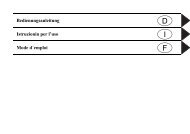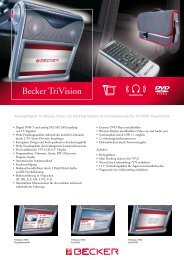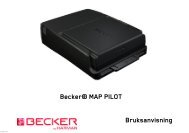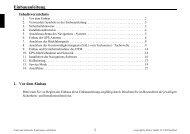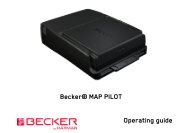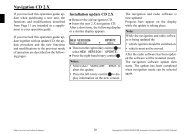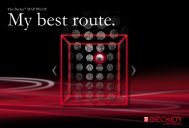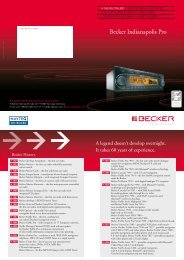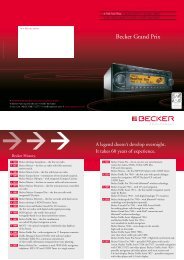Information regarding general road safety
Information regarding general road safety
Information regarding general road safety
Create successful ePaper yourself
Turn your PDF publications into a flip-book with our unique Google optimized e-Paper software.
43<br />
<strong>Information</strong> <strong>regarding</strong> <strong>general</strong> <strong>road</strong> <strong>safety</strong><br />
This car radio device is intended and approved for installation and operation in passenger cars, commercial vehicles<br />
and buses (vehicle classes M, N and O) whose electric system has a rated voltage of 12V.<br />
Installation and maintenance should only be carried out by specialists. Faulty installation or maintenance can result<br />
in the malfunctioning of the motor vehicle’s electronic systems. The vehicle manufacturer’s <strong>safety</strong> instructions must<br />
be observed.<br />
The vehicle’s electronics (e.g. speedometer signal) must only be worked on by an authorised service garage. We<br />
assume no liability for any impairment of the vehicle’s electronics.<br />
This device is only intended for installation in the area provided for this purpose by the vehicle manufacturer.<br />
The method of attachment used must ensure that the device will remain properly attached, should the vehicle be<br />
involved in a crash.<br />
The power supply must be properly fused.<br />
Using mobile phones without an external antenna in the proximity of the radio unit may cause interference.<br />
Familiarise yourself with the device and how it works before embarking on your journey. Whilst on the move, only<br />
operate the device in appropriate traffic conditions. The volume of the device should be set at a level that enables<br />
external noises (e.g. police sirens) to be easily heard.
Table of Contents<br />
Inhaltsverzeichnis<br />
<strong>Information</strong> <strong>regarding</strong> <strong>general</strong> <strong>road</strong> <strong>safety</strong> 43<br />
Inhaltsverzeichnis 44<br />
Arrangement of controls 46<br />
Anti-theft device 47<br />
Entering the code number 47<br />
General operation 48<br />
Switching on / off 48<br />
Setting the volume 48<br />
Activating the tone menu 48<br />
Setting the bass 48<br />
Setting the treble 48<br />
Fader 49<br />
Setting the balance 49<br />
Linear adjustment 49<br />
Switching loudness on / off<br />
Adjusting the volume of the subwoofer or<br />
49<br />
centre speaker 50<br />
Radio mode 51<br />
Switching on FM mode 51<br />
Switching on FM menu mode 51<br />
Selecting FM memory level 51<br />
Settings for FM station selection 51<br />
Dynamic autostore (FM-DAS) 52<br />
Station search FM - DAS 52<br />
FM Scan search 53<br />
Programme filtering for FM DAS 53<br />
Programme type selection (PTY) 54<br />
45<br />
Turning PTY display on / off 54<br />
Calling up / storing FM stations 54<br />
Manual FM tuning 55<br />
Regionalisation 55<br />
Switching regionalisation on / off 56<br />
Turning frequency display on or off 56<br />
Switching radio text on / off 56<br />
Traffic programme (TP) 57<br />
Activating / quitting the TP menu 57<br />
Switching TP on / off 58<br />
Selecting automatic tracking 58<br />
Selecting / cancelling direct programming 58<br />
Switching mute function on / off 59<br />
Interrupting TP announcements 59<br />
TP Announcement volume 59<br />
Telephone mute function 60<br />
Selecting AM mode 60<br />
Switching on AM menu mode 60<br />
Select AM band 60<br />
Settings for AM station selection 61<br />
Station search MW, LW, SW 61<br />
AM Scan search 61<br />
Calling up / storing MW, LW, SW stations 61<br />
Autostore MW, LW 62<br />
Manual tuning MW, LW, SW 62
CD mode 63<br />
Notes on compact discs (CD) 63<br />
Note on condensation of humidity 63<br />
Notes on CD-R and CD-RWs 63<br />
Notes on copy-protected CDs 63<br />
Inserting / ejecting CDs 64<br />
Forward / backward track skipping 64<br />
Scan search 64<br />
Fast forward / reverse 65<br />
Random play 65<br />
Track repeat 65<br />
Track display 65<br />
Display CD text 66<br />
Temperature protection circuit 66<br />
MP3 mode 67<br />
General instructions for MP3 67<br />
Creating an MP3 storage medium 67<br />
Selecting a directory 68<br />
Track display 68<br />
Total number of tracks 68<br />
Displaying the track name 69<br />
CD changer mode 70<br />
Operational readiness of CD changer 70<br />
Loading / ejecting the CD magazine 70<br />
Playing CDs 70<br />
Selecting CDs 71<br />
Naming a CD 71<br />
CD filter function 72<br />
Table of Contents<br />
User menu 73<br />
Calling up / exiting user menu 73<br />
Setting the GAL (Gal) 73<br />
Telephone mute function (Tel) 74<br />
LED setting 74<br />
Setting reception optimisation (M/S) 74<br />
AUX input (Aux) 75<br />
Signal tone volume (Bev) 75<br />
Service menu 76<br />
Calling up / exiting service menu 76<br />
Triggering a reset 76<br />
Connection instructions 77<br />
Installation and removal instructions 78<br />
General instructions 80<br />
RDS SYSTEM 80<br />
DAS Seek Qual. level 80<br />
DAS Seek Name level 80<br />
RDS Stations level 80<br />
Stations Fix level 80<br />
PTY (programme type) 81<br />
Technical data 82<br />
NOTICE 83<br />
46
Arrangement of controls<br />
47<br />
Arrangement of controls<br />
1 Left-hand rotary control<br />
2 On / off switch ( )<br />
3 Road traffic announcement button ( )<br />
4 Tone button ( )<br />
5 Menu button ( )<br />
6 LED (anti-theft warning)<br />
7 CD mode selection ( )<br />
8 FM mode selection ( )<br />
9 AM mode selection ( )<br />
10 CD eject button ( )<br />
11 Right-hand rotary control<br />
12 Multifunction buttons<br />
13 Display
Anti-theft device<br />
Entering the code number<br />
If the car radio is disconnected from the electrical supply<br />
source, the anti-theft device prevents it from being reconnected.<br />
After switching on via the button, the prompt Enter<br />
Code Number is displayed.<br />
Using multifunction buttons - , enter the fivedigit<br />
code number.<br />
Example: Code number 15372 (the code number can be<br />
found on the enclosed CODE CARD).<br />
Enter code number using the multifunction buttons.<br />
The unit automatically switches on when the fifth digit is<br />
entered and all other digits were entered correctly.<br />
Note: It is important to store the CODE CARD in a safe<br />
place outside of the vehicle. This will prevent unauthorised<br />
use. The window stickers provided<br />
should be attached to the windscreen/windows inside<br />
your vehicle.<br />
Anti-theft device<br />
If an incorrect code number is entered, the prompt Enter<br />
Code Number will be displayed again. If an incorrect code<br />
number is entered three times in a row, the unit will display<br />
Code wait , and the unit will be blocked for approximately<br />
60 minutes.<br />
Three further incorrect entries block the unit for another<br />
60 minutes.<br />
Attention: The blocking time will elapse only while the<br />
unit is turned on.<br />
48
General operation<br />
General operation<br />
Switching on / off<br />
Press .<br />
Alternatively, switch on/ off: via the vehicle ignition. To<br />
switch the unit on via the ignition, the unit must have previously<br />
been turned off via the ignition. After switching off the<br />
ignition, the unit can be prevented from switching off by<br />
pressing the button within 3 seconds.<br />
Note: The unit can also be switched on with the ignition<br />
switched off via the button, but it will switch<br />
off automatically after 1 hour.<br />
Setting the volume<br />
Turn the left-hand rotary control . The volume increases or<br />
decreases.<br />
Activating the tone menu<br />
Press . The tone menu is activated. The following<br />
functions can be called up: Bas (Bass), Trb (Treble),<br />
Fad (Fader), Bal (Balance), Flt (Linear Setting), Sub (Subwoofer)<br />
and Ldn (Loudness).<br />
49<br />
Bass, treble, fader, balance, and loudness settings for the FM,<br />
AM (MW, LW, SW) wavebands; <strong>road</strong> traffic announcements;<br />
telephone operation; audio CD, MP3 CD and CDC/<br />
AUX operation are stored separately.<br />
Setting the bass<br />
Press the button and then the multifunction<br />
button.<br />
Set the desired bass level using the right-hand rotary<br />
control .<br />
Setting the treble<br />
Press the button and then the multifunction<br />
button.<br />
Set the desired treble level using the right-hand rotary<br />
control .
Fader<br />
Press the button and then the multifunction<br />
button.<br />
Use the right-hand rotary control to achieve the desired<br />
fader setting.<br />
Setting the balance<br />
Press the button and then the multifunction<br />
button.<br />
Set the desired balance level using the right-hand rotary<br />
control .<br />
Linear adjustment<br />
Briefly press the button.<br />
General operation<br />
Briefly press the multifunction button - Tone flat is<br />
displayed. Pressing the multifunction button again will<br />
reset the tone adjustments for the current signal source<br />
(e.g. FM) to mid-level.<br />
Switching loudness on / off<br />
Press the button and then the multifunction<br />
button.<br />
You can use the multifunction button to select either<br />
Loudness on (ON) or Loudness off (OFF).<br />
For the MW, LW and SW wavebands, loudness is turned off.<br />
50
General operation<br />
Adjusting the volume of the subwoofer or centre<br />
speaker<br />
Press the button and then the multifunction<br />
button.<br />
Use the right-hand rotary control to achieve the desired<br />
subwoofer volume setting.<br />
51
Radio mode<br />
Switching on FM mode<br />
Press .<br />
The FM waveband will start up with the memory level that<br />
was last selected.<br />
Switching on FM menu mode<br />
Press the button whilst in FM mode.<br />
The FM menu mode is activated and displayed. If no button<br />
is pressed within the next 8 seconds, FM menu mode will be<br />
cancelled.<br />
Selecting FM memory level<br />
Switching on FM menu mode<br />
The DAS Seek Qual., DAS Seek Name, Stations RDS and<br />
Stations Fix memory levels can be selected by pressing<br />
the multifunction button repeatedly.<br />
• DAS Seek Qual. (see also page 81).<br />
• DAS Seek Name (see also page 81)<br />
• Stations RDS (see also page 81)<br />
• Stations Fix (see also page 81)<br />
Radio mode<br />
Settings for FM station selection<br />
The desired station can be selected via dynamic autostore, station<br />
search, scan search, manual tuning, and station buttons.<br />
52
Radio mode<br />
Dynamic autostore (FM-DAS)<br />
Whilst in FM menu mode, press the multifunction button<br />
as many times as necessary to display DAS Seek Qual.<br />
or DAS Seek Name.<br />
In FM DAS mode, the receivable stations are displayed via the<br />
multifunction buttons depending on the settings.<br />
Set the desired station by pressing the button directly below<br />
the abbreviated station designation. If the selected b<strong>road</strong>caster<br />
transmits several programmes/regional programmes, a submenu<br />
is automatically displayed so that the desired<br />
programme can be selected.<br />
53<br />
If a programme has previously been selected that belongs to<br />
the particular station programming chain, the last stored programme<br />
entry will be automatically selected.<br />
The multifunction button shows which buttons can be<br />
pressed to display and select other stations.<br />
In cases where the station name is being misused for the purpose<br />
of b<strong>road</strong>casting adverts or news, the abbreviation L-1...<br />
L-Z (L = Local) is used. This prevents the lower display line<br />
from constantly changing. When a station is selected, it is<br />
identified by a star (e.g. L*1).<br />
The first time the unit is operated, or after the electrical supply<br />
has been interrupted, it may take the radio some time to evaluate<br />
the station signals. The display will appear incrementally<br />
as the evaluation progresses.<br />
Station search FM - DAS<br />
Turn the right-hand rotary control to the left or right. The<br />
radio displays the receivable and identified stations in descending/ascending<br />
order.
FM Scan search<br />
Press the right-hand rotary control whilst in FM mode and<br />
will be displayed.<br />
An automatic station search will be initiated. The first run is<br />
performed on an insensitive plane, all further runs on a sensitive<br />
plane. Receivable stations will remain audible for 8 seconds.<br />
If you wish to select one, press the right-hand rotary<br />
control again.<br />
Note: With FM DAS, the Scan search is conducted in alphabetical<br />
order.<br />
Radio mode<br />
Programme filtering for FM DAS<br />
You have the option of filtering various stations from the FM<br />
DAS station list.<br />
Whilst in FM menu mode, press the multifunction button.<br />
The individual programmes can be selected using the righthand<br />
rotary control . By pressing the right-hand rotary<br />
control , you can choose between Play (programme unfiltered)<br />
and Skip (programme filtered out).<br />
To turn the filter function on or off, press the multifunction<br />
button repeatedly to turn the filter function on<br />
(Fil on) or off (No Fil).<br />
54
Radio mode<br />
Programme type selection (PTY)<br />
Whilst in FM menu mode, press the multifunction button.<br />
Afterwards, select the desired PTY (see also page 82) using<br />
the multifunction button.<br />
Note: Only the currently available PTYs can be selected.<br />
If a PTY is selected in FM DAS mode, only those stations with<br />
this particular PTY can be selected.<br />
By selecting NO PTY whilst in FM-DAS mode, all stations<br />
will once again be displayed.<br />
Turning PTY display on / off<br />
Switching on FM menu mode<br />
Use the multifunction button to select either PTY (PTY<br />
Display On) or Frequency (PTY Display Off).<br />
55<br />
Calling up / storing FM stations<br />
Whilst in FM menu mode, use the multifunction button<br />
to select either the Stations RDS or the Stations Fix<br />
memory levels<br />
- Stations RDS (see also page 81)<br />
- Stations Fix (see also page 81)<br />
Storing: 12 frequencies or programmes can be stored per<br />
waveband.<br />
To store the desired station or program, press the multifunction<br />
button - or - until you hear a<br />
signal tone.<br />
To reach presets 10 – 12, press the multifunction button.<br />
Calling up a preset: Press multifunction button -<br />
or - and the stored station will be called<br />
up.
Manual FM tuning<br />
Whilst in FM menu mode, use the multifunction button<br />
to select the Stations Fix level.<br />
Press the multifunction button twice.<br />
Next, turn the right-hand rotary control .<br />
Tuning is performed in increments of 100 kHz.<br />
If manual tuning is currently active MAN will be shown in the<br />
display. If the right-hand rotary control is not turned immediately,<br />
after a short while MAN will disappear from the display<br />
and manual tuning will be cancelled.<br />
Regionalisation<br />
The RDS diversity function is independent of region. As a result,<br />
the RDS diversity function can lead to the radio switching<br />
between various regional programmes which may vary in<br />
terms of b<strong>road</strong>casting content. In such a case, the special regional<br />
programming must be selected directly.<br />
If several regional programmes are transmitted by one station,<br />
this can only be seen when the station is selected.<br />
Stations with various regional alternatives are indicated by<br />
means of a star (e.g. 4*).<br />
Radio mode<br />
When one of these stations is selected (e.g. 4*), all receivable<br />
regional alternatives for this station will be displayed.<br />
You can then select the desired regional alternative<br />
(e.g. ).<br />
If the signal quality of a regional alternative drifts despite the<br />
RDS Diversity function, it may mean that regional alternatives<br />
are only transmitted on a few frequencies. Therefore,<br />
there are fewer frequencies with strong signals available for<br />
the unit to switch to.<br />
56
Radio mode<br />
Switching regionalisation on / off<br />
Switching on FM menu mode<br />
Use the multifunction button to turn regionalisation on<br />
(on) or off (off).<br />
Turning frequency display on or off<br />
Switching on FM menu mode<br />
Use the multifunction button to select either<br />
Frequency (Frequency display on) or PTY (Frequency<br />
display off).<br />
57<br />
Switching radio text on / off<br />
Press the left-hand rotary control to display radio text for<br />
the currently selected FM station.<br />
The car radio filters data transmitted by the radio station and<br />
displays it in the form of radio text.<br />
Radio text cannot be displayed unless the selected station<br />
transmits it in the first place.<br />
Poor reception or interference may distort the radio text or<br />
prevent it from being displayed completely.<br />
In order to quit the radio text level, press the button or<br />
the left-hand rotary control .<br />
Note: Since information transmitted via radio text is<br />
constantly changing, we recommend displaying<br />
the radio text only when the vehicle is stationary<br />
to avoid unnecessary distraction for the<br />
driver. This is a necessary precaution for accident<br />
prevention.
Traffic programme (TP)<br />
If an RDS Diversity station b<strong>road</strong>casts TP announcements,<br />
the CD-, MP3,- CDC/AUX-, MW-, LW-, and SW modes can<br />
be interrupted or the mute function suspended in order to<br />
switch to the TP announcements. Moreover, you can listen to<br />
one FM station while receiving TP announcements transmitted<br />
by another FM station.<br />
There are two ways to select a TP transmitter:<br />
- automatic tracking<br />
- direct programming<br />
Automatic tracking always uses the FM station currently being<br />
received as the TP transmitter. If the selected FM station<br />
has poor signal quality or cannot function as a TP transmitter,<br />
the unit applies specified criteria to search for a new TP transmitter.<br />
With direct programming, a TP station other than the one<br />
being listened to can be programmed. This means, for example,<br />
that a particular FM station can be listened to whilst TP<br />
announcements are received from another one.<br />
If the programmed TP transmitter reception is poor, the unit<br />
switches to automatic tracking until the programmed TP<br />
transmitter can be restored.<br />
Radio mode<br />
If an RDS station features traffic programmes, this is indicated<br />
on the display by TP.<br />
An inverse appears on the display to indicate that the traffic<br />
programme is active.<br />
Activating / quitting the TP menu<br />
Activating: Press the button (traffic announcements<br />
must not be transmitted).<br />
Press the multifunction button.<br />
Quitting: Press the button; otherwise, the TP menu<br />
will automatically disappear after 8 seconds if no further operations<br />
are performed.<br />
58
Radio mode<br />
Switching TP on / off<br />
In all modes and wavebands, TP can be turned on or off by<br />
pressing and holding the button for more than 2 seconds.<br />
TP can also be switched on or off whilst in the TP menu.<br />
Switching on: To turn on TP in the TP Menu, repeatedly<br />
press the multifunction button until TP on appears.<br />
Switching off: To switch TP off whilst in the TP Menu, press<br />
the multifunction button repeatedly until TP off appears.<br />
TP is switched off after returning to normal display.<br />
59<br />
Selecting automatic tracking<br />
In all modes and wavebands, automatic tracking can be turned<br />
on by pressing and holding the button for more than<br />
2 seconds.<br />
To switch on automatic tracking whilst in the TP Menu, press<br />
the multifunction button repeatedly until TP on appears.<br />
Note: If a TP station has already been programmed<br />
directly, it will once again be selected as the TP<br />
station.<br />
Selecting / cancelling direct programming<br />
Activate the TP menu.<br />
Selecting: Press the multifunction button.<br />
Use the right-hand rotary control to select the desired TP<br />
station. After a short delay and without actuation, the selected<br />
transmitter is accepted.<br />
Cancelling: Press the multifunction button.
Use the right-hand rotary control to select Autoselect<br />
and press to confirm. After a short delay and without actuation,<br />
direct programming is cancelled.<br />
Quit the TP menu.<br />
Switching mute function on / off<br />
Once a TP or EON station has been selected, the mute function<br />
can be activated by briefly pressing the button.<br />
Following this, only traffic announcements will be switched<br />
through. The mute function is cancelled by pressing the<br />
button again.<br />
Radio mode<br />
Interrupting TP announcements<br />
Briefly press the button during the TP announcement.<br />
The announcement currently being b<strong>road</strong>cast will be interrupted<br />
and the system will automatically return to the previously<br />
selected mode.<br />
TP Announcement volume<br />
Activate TP Menu. Press the multifunction button.<br />
With the right-hand rotary control , four different settings<br />
(0 - 3) can be selected. This means that the volume can be<br />
raised by a fixed amount depending on the setting.<br />
• Setting 0 - No increase<br />
• Setting 1 - Slight increase<br />
• Setting 2 - Medium increase<br />
• Setting 3 - Strong increase<br />
60
Radio mode<br />
Telephone mute function<br />
If a telephone is installed in the vehicle and its mute control is<br />
linked to the car radio, the User menu (Page 75) can be used<br />
to determine how it should behave.<br />
With the mute setting selected, the radio will be switched to<br />
mute when a call comes in. Phone Mute will appear in the<br />
display.<br />
With the audio signal setting selected, the telephone’s<br />
ringtone will be heard through the radio unit if a call comes in<br />
(vehicle ignition must be on).<br />
This is only possible if, in addition to the telephone, a handsfree<br />
unit with loudspeaker output is installed and connected to<br />
the radio. If this is the case Phone will be displayed.<br />
61<br />
Selecting AM mode<br />
Press .<br />
The last selected AM waveband is called up.<br />
Switching on AM menu mode<br />
Press the button whilst in AM mode.<br />
The AM menu mode is activated and displayed. If no button<br />
is pressed within the next 8 seconds, AM menu mode will be<br />
cancelled.<br />
Select AM band<br />
Switching on AM menu mode<br />
Press the multifunction button repeatedly to choose between<br />
MW (Medium Wave), LW (Long Wave) and SW<br />
(Short Wave) wavebands.
Settings for AM station selection<br />
The desired station can be selected via autostore (MW, LW),<br />
station search, scan search, manual tuning and station buttons.<br />
Station search MW, LW, SW<br />
Whilst in the desired waveband (MW, LW or SW) turn the<br />
right-hand rotary control to the left or right. The radio<br />
searches for reception frequencies in descending or ascending<br />
order of frequency.<br />
AM Scan search<br />
Whilst in the desired waveband (MW, LW or SW) press the<br />
right-hand rotary control and will be displayed.<br />
An automatic station search will be initiated. The first run is<br />
performed on an insensitive plane, all further runs on a sensitive<br />
plane. Receivable stations will remain audible for 8 seconds.<br />
If you wish to store one, press the right-hand rotary<br />
control .<br />
Radio mode<br />
Calling up / storing MW, LW, SW stations<br />
Storing: In each case up to 12 stations can be stored using the<br />
station buttons. Search for the desired station and press the<br />
desired multifunction button until a signal tone sounds.<br />
To reach presets 10 – 12, press the multifunction button.<br />
Calling up stations: Press multifunction buttons -<br />
or - and the stored station will be called<br />
up.<br />
62
Radio mode<br />
Autostore MW, LW<br />
Switching on AM menu mode<br />
Press the multifunction button until Autostore on is<br />
displayed.<br />
Keep pressing the multifunction button until Seek<br />
Autostore is displayed.<br />
The 6 stations with the strongest signal will be stored under<br />
the station buttons in order of signal strength.<br />
To exit the autostore memory level, turn off the autostore<br />
memory level (off) using the multifunction button.<br />
The radio switches back to the station button level.<br />
63<br />
Manual tuning MW, LW, SW<br />
Switching on AM menu mode<br />
Press the multifunction button twice.<br />
Then turn the right-hand rotary control .<br />
Tuning will be in increments of 9kHz (MW), 3kHz (LW) or<br />
5kHz (SW).<br />
If manual tuning is currently active MAN will be shown in the<br />
display. If the right-hand rotary control is not turned<br />
immediately, after a short while MAN will disappear from the<br />
display and manual tuning will be cancelled.
CD mode<br />
Notes on compact discs (CD)<br />
Sound interruptions may occur if the CD is soiled. In order to<br />
ensure optimum tone quality, please note the following:<br />
• Always touch the CD at the edges only. Keep the disc<br />
clean and never touch the surface.<br />
• Never stick anything on the CD.<br />
• Protect the CDs against direct sunlight and from heat<br />
sources such as heaters etc.<br />
• Before playing the CD, it should be cleaned with a special,<br />
commercially available cleaning cloth, wiping from the<br />
centre outwards. Solvents such as benzene, thinners or<br />
other commercially available cleaners and anti-static<br />
sprays must not be used.<br />
Correct<br />
Incorrect<br />
Incorrect<br />
Correct<br />
CD mode<br />
Note on condensation of humidity<br />
During periods of rain or extreme humidity, humidity may<br />
condense on the lenses located inside the unit. This will impair<br />
the unit’s ability to perform CD playback. Remove the<br />
CD from the drive and wait for approximately one hour to allow<br />
the condensation to evaporate.<br />
Notes on CD-R and CD-RWs<br />
You can play CD-Rs/CD-RWs (writeable/rewritable CDs) on<br />
this unit, but please comply with legal restrictions. These restrictions<br />
may vary from one country to another.<br />
Depending upon the recording device used to record the CD-<br />
R/CD-RW and / or the CD-R/CD-RW itself, it may not be<br />
possible to play some CD-Rs/CD-RWs on this unit.<br />
CD-Rs/CD-RWs must be manufactured according to the<br />
“Red Book” or “Yellow Book” standards (not applicable to<br />
MP3-CD’s).<br />
Notes on copy-protected CDs<br />
In some cases, problems may arise when attempting to play<br />
copy-protected CDs, such as long reading times or a total inability<br />
to perform playback.<br />
64
CD mode<br />
Inserting / ejecting CDs<br />
Insertion:<br />
Insert the disc into the CD slot with the printed side facing upwards.<br />
The CD will be drawn into the unit automatically. In<br />
the case of an audio CD, the unit will then begin to play the<br />
first track and in the case of an MP3 CD, the first track in the<br />
first directory.<br />
After the last track of the CD has finished playing, the unit<br />
will automatically repeat the CD from the first track.<br />
If there is already a CD in the slot, press the button. If<br />
CD changer / AUX mode was the last selection made, then the<br />
multifunction button must be used to switch to CD<br />
mode or the multifunction button used to switch to<br />
MP3 mode.<br />
Ejecting the CD:<br />
To eject a CD, press the button, and the CD will be ejected.<br />
Remove the CD.<br />
Attention: When the unit is turned off, the CD will not<br />
be ejected, but will remain in the CD slot.<br />
65<br />
Forward / backward track skipping<br />
Audio CD tracks or tracks from the current MP3 CD directory<br />
can be selected by turning the right-hand rotary control.<br />
When you get to the last track, in the case of an audio CD the<br />
unit continues to the first track or in the case of an MP3 CD,<br />
to the first directory. In a similar manner, it switches from the<br />
first track back to the final track.<br />
If a track has been playing for more than 10 seconds when the<br />
skip button is pressed, the unit will skip back to the beginning<br />
of the selected track.<br />
Scan search<br />
Press right-hand rotary control , will appear in the display.<br />
All following CD tracks are played for 12 seconds each. Press<br />
the right-hand rotary control again to terminate the scan<br />
search.
Fast forward / reverse<br />
Fast forward (audible) is activated by pressing the<br />
multifunction button and fast reverse (audible) is activated by<br />
pressing the multifunction button.<br />
Fast forward / reverse terminates when the multifunction button<br />
is released.<br />
Note: Fast reverse terminates automatically as soon as<br />
the beginning of the current track is reached.<br />
Random play<br />
Pressing the multifunction button activates the random<br />
play function. Subsequently, the titles from the current CD<br />
will be played in random order. The prompt Rnd is displayed<br />
inversely.<br />
Pressing the multifunction button again deactivates the<br />
“Random play” function.<br />
CD mode<br />
Track repeat<br />
"Track repeat" is activated by pressing the multifunction<br />
button. The prompt Rpt is displayed inversely.<br />
Pressing the multifunction button again deactivates<br />
“Track repeat”.<br />
Track display<br />
Press the button in CD mode.<br />
Pressing the multifunction button will briefly display<br />
the number of the current track and the total number of tracks.<br />
66
CD mode<br />
Display CD text<br />
If the CD features CD text information, this can be displayed.<br />
Press the left-hand rotary control whilst in CD mode.<br />
If CD text information is available for the current track, it will<br />
be displayed. If no CD text is available No Info will be displayed.<br />
If CD text information is already active when the next track is<br />
played, the display will be updated automatically.<br />
CD text will continue to be displayed until the unit is switched<br />
off or the left-hand rotary control or the button is<br />
pressed.<br />
67<br />
Temperature protection circuit<br />
To protect the laser diode from excessive heat, a temperature<br />
protection circuit is integrated into the unit.<br />
On activation of the temperature protection circuit, Temp will<br />
appear for 8 seconds and the unit will be switched back to the<br />
radio source.<br />
After a cool down period, single CD mode or CD changer<br />
mode can be called up again. If the temperature is still too<br />
high, the unit will once again switch back to the previously selected<br />
radio source.
MP3 mode<br />
General instructions for MP3<br />
The music that can be played when your unit is in MP3 mode<br />
is <strong>general</strong>ly copyright-protected under applicable international<br />
and national laws. In several countries, the reproduction of<br />
copyrighted material is not permitted, even if only for personal<br />
use, without the express prior consent of the copyright<br />
holder. Please check the current copyright laws for your country<br />
and comply with them. These restrictions naturally do not<br />
apply to your own compositions and recordings, or for recordings<br />
for which authorisation has been obtained from the<br />
copyright holder.<br />
Creating an MP3 storage medium<br />
• The maximum number of files per medium is 400.<br />
• Only MP3 music files stored on a CD in compliance with<br />
ISO 9660 can be played.<br />
• If the artist’s name and track title are to be displayed, an<br />
ID3 tag must be added to the MP3 file. This unit supports<br />
versions ID3v1 and ID3v2 with a maximum acceptable<br />
tag length of 4 KB.<br />
• The display of artist’s name and track title is restricted to<br />
a total maximum length of 50 characters.<br />
MP3 mode<br />
• The MP3 formats MPEG1, MPEG2 and MPEG2.5<br />
Layer3 are supported by the unit.<br />
Fixed and variable bit rates of 8 -280 kbit/s and scan rates<br />
of 8-48 kHz are supported.<br />
• We recommend a bit rate of at least 160 kbit/s for compressing<br />
MP3 files. It should be noted that with MP3 files<br />
having a variable bit rate, the display of the elapsed playing<br />
time may deviate from real time.<br />
• If both MP3 data and conventional audio tracks are included<br />
on the CD it is usually referred to as a mixed-mode<br />
CD. On this kind of CD the audio tracks are <strong>general</strong>ly located<br />
in the first directory on the CD.<br />
For further information about creating MP3 files and ID3<br />
tags, please consult your dealer or check on the Internet.<br />
Note: Due to the abundance of different kinds of CD<br />
burning software and their associated settings we<br />
cannot guarantee the playback quality of MP3<br />
CDs.<br />
68
MP3 mode<br />
Selecting a directory<br />
If the files on the MP3 CD are arranged in several folders, the<br />
folders will be handled in a similar manner to different CDs<br />
in the CD changer.<br />
The individual directories can be selected by pressing multifunction<br />
buttons and . The number after Fd<br />
shows you which directory is currently selected.<br />
Once the last track in the directory has been played, the next<br />
directory will be selected and played automatically.<br />
For additional operating instructions, refer to CD mode<br />
(Page 64):<br />
• “Notes on compact discs (CD)” on page 64<br />
• “Forward / backward track skipping” on page 65<br />
• “Scan search” on page 65<br />
• “Fast forward / reverse” on page 66<br />
• “Random play” on page 66<br />
• “Track repeat” on page 66<br />
69<br />
Track display<br />
Press the button whilst in MP3 mode.<br />
Pressing the multifunction button will briefly display<br />
the number of the current track and the total number of tracks<br />
in the currently selected directory.<br />
Total number of tracks<br />
Press the button whilst in MP3 mode.<br />
Pressing the multifunction button will briefly display<br />
the number of all directories and the total number of tracks<br />
they contain.
Displaying the track name<br />
After pressing the left-hand rotary control , the artist’s<br />
name and track name are displayed in the format “Artist’s<br />
name – Track name”. However, this is only displayed if an<br />
ID3 tag with the corresponding content is provided.<br />
If no ID3 tag or an ID3 tag that lacks this information is provided,<br />
No Info will be displayed.<br />
Text exceeding the length of the display will be presented as<br />
moving text (from right to left). If the ID3 tag function is already<br />
active when the next track is played, the display will be<br />
updated automatically.<br />
ID3 tags will continue to be displayed until the unit is<br />
switched off or the left-hand rotary control or the<br />
button is pressed.<br />
MP3 mode<br />
70
CD changer operation<br />
CD changer mode<br />
Operational readiness of CD changer<br />
If a CD changer is connected to the car radio, the CD changer<br />
is ready for operation as soon as the filled CD magazine is<br />
loaded. Close the sliding cover after loading. All further<br />
operation is performed from the car radio control panel.<br />
Loading / ejecting the CD magazine<br />
To remove the CD magazine, open the sliding cover on the<br />
changer and press the eject button. The magazine is ejected<br />
and can be removed.<br />
When inserting CDs into the magazine, please note the<br />
instructions printed on the magazine.<br />
Attention: Incorrectly inserted CDs will not be played.<br />
Note: To allow for the fastest possible change of CDs,<br />
the magazine should be loaded successively, beginning<br />
with compartment 1.<br />
71<br />
Playing CDs<br />
Press . If the unit was last set to CD changer operation<br />
or there is no CD in the CD drive, the CD changer menu is<br />
now active.<br />
If CD operation was selected last, the unit must be switched<br />
to CD changer operation by pressing the multifunction<br />
button.<br />
Playback begins with the last CD played, at the track playing<br />
before switching off.<br />
For additional operating instructions, refer to CD mode<br />
(Page 64):<br />
• ”Notes on compact discs (CD)” on page 64<br />
• ”Forward / backward track skipping” on page 65<br />
• ”Scan search” on page 65<br />
• ”Fast forward / reverse” on page 66<br />
• ”Random play” on page 66<br />
• ”Track repeat” on page 66<br />
• ”Track display” on page 66
Selecting CDs<br />
The individual CDs in the magazine can be selected by pressing<br />
multifunction buttons and .<br />
During the selection time, Loading CD X is displayed. The<br />
magazine compartment number or the name of the CD (if allocated)<br />
and the number of the current track on the selected<br />
CD are then displayed.<br />
If no CD is loaded in the selected magazine compartment (e.g.<br />
compartment 2), NO CD 2 will briefly appear on the display.<br />
After playing the last track of a CD, the unit automatically selects<br />
and plays the next CD in the magazine.<br />
Naming a CD<br />
Press in CD changer mode.<br />
Then press multifunctionbutton .<br />
CD changer mode<br />
To name a CD or to change an existing name, press multifunction<br />
button .<br />
Using multifunction buttons and , select the desired<br />
position (inverse editing symbol).<br />
72
CD changer operation<br />
Using the right rotary control , select the desired letters and<br />
press the control to confirm.<br />
Press the right rotary control to move to the next position.<br />
A maximum of 8 characters can be entered.<br />
The name is stored after exiting the CDC menu.<br />
To delete an existing name, press multifunction button .<br />
Using the right rotary control , select the name to be<br />
deleted.<br />
Now, press multifunction button to delete the name.<br />
73<br />
CD filter function<br />
Press in CD changer mode.<br />
Then press multifunction button .<br />
For the Silverstone 2660 CD changer, the individual tracks of<br />
the current CD can be selected using the right rotary<br />
control . By pressing the right rotary control selection<br />
can be made between Play (track unfiltered) and Skip (track<br />
filtered out).<br />
To switch the filter function on or off, press the multifunction<br />
button repeatedly to switch the filter function on<br />
(Fil on) or off (No Fil).<br />
For the Silverstone 2630 and 2640 CD changers, it is possible<br />
to select between Play (track unfiltered) and Skip (track filtered<br />
out) for the current track by pressing the right rotary<br />
control .<br />
The filter function is not available for the Silverstone 7860<br />
CD changer.<br />
Attention: The filter function can only be activated<br />
when the selected CD has been named.
User menu<br />
Calling up / exiting user menu<br />
The user menu is called up by pressing the key.<br />
After calling up the user menu, the following basic settings<br />
can be made on two levels according to your personal preferences.<br />
• Gal - Speed dependent volume control (GAL)<br />
• Tel - Adjusting telephone function settings<br />
• M/S - Setting for reception optimisation<br />
• Aux - Setting for the AUX input<br />
• Bev - Adjustment of signal tone volume<br />
Quitting:<br />
To quit the user menu, press the button again. Alternatively,<br />
the menu will be cancelled after a short delay if<br />
no further operations are performed.<br />
User menu<br />
Setting the GAL (Gal)<br />
The GAL is a car radio control circuit, which automatically<br />
adjusts the car radio volume according to vehicle speed. This<br />
results in compensation of the driving noise produced at higher<br />
speeds. If you wish to make use of this feature, a speed signal<br />
must be linked to the unit.<br />
Call up the user menu. Press the multifunction button.<br />
Use the right-hand rotary control , to choose a value between<br />
0 and +15.<br />
The GAL setting can be used to specify the starting point for<br />
the volume adjustment according to vehicle speed.<br />
The setting is stored automatically.<br />
The settings are:<br />
• 0 - No volume increase<br />
• +1 - Volume increase begins at low vehicle speed<br />
• +15 - Volume increase begins at higher vehicle speed<br />
74
User menu<br />
Telephone mute function (Tel)<br />
If a telephone with hands-free operation is installed, the call<br />
may be routed through the speaker system. This eliminates<br />
the need for an additional speaker. However, the signal leads<br />
(AF – Telephone input and Earth – Telephone input) must be<br />
connected to the car radio (see page 83).<br />
To set, call up user menu. Press the multifunction button<br />
to choose between Audio Sig. (audio signal) and Mute.<br />
• Mute - Telephone mute setting<br />
• Audio Sig. - Telephone conversation via car radio<br />
75<br />
LED setting<br />
This function can be used to switch the LED function (flashes<br />
when the unit is switched off) on and off.<br />
Call up user menu. Press the multifunction button to<br />
choose between blinking (LED on) and off (LED off).<br />
The setting is stored automatically.<br />
Setting reception optimisation (M/S)<br />
In order to suppress reception-related interference, three different<br />
parameters can be set for reception optimisation.<br />
Call up user menu. Press the multifunction button to<br />
select Stereo, Mono or Auto.<br />
• Auto: Setting for normal operation - i.e. the unit switches<br />
from stereo to mono reception and back, depending on the<br />
reception conditions (for nearly all reception areas, this is<br />
the optimal setting).
• Stereo: Setting for exceptional reception conditions - i.e.<br />
the unit is constantly set to stereo.<br />
• Mono: Setting for reception conditions in which reflections<br />
constantly occur - i.e., the unit is constantly set to<br />
mono.<br />
The setting is effective immediately and is also retained after<br />
power is turned off.<br />
AUX input (Aux)<br />
This can be used to switch on the CD changer AF connections<br />
if no CD changer is connected. An external unit (Discman,<br />
Walkman, etc.) can then be connected.<br />
To set, call up user menu. Use the multifunction button<br />
to select either AUX Mode on (on) or Aux Mode off (off)<br />
The setting is stored automatically.<br />
The multifunction button must be pressed whilst in CD<br />
mode to select AUX mode.<br />
User menu<br />
Signal tone volume (Bev)<br />
The volume of signal tones (e.g. storage confirmation) can be<br />
set using this function.<br />
Press the multifunction button. Use the right-hand<br />
rotary control to select between 0 (Quiet) or +5 (Loud).<br />
The setting is stored automatically.<br />
76
Service menu<br />
Service menu<br />
Calling up / exiting service menu<br />
To select the service menu, press the button and the<br />
multifunction button 10 whilst in radio mode.<br />
The individual entries can be selected by pressing multifunction<br />
buttons and , or by turning the right-hand<br />
rotary control .<br />
To exit the Service menu, press the multifunction<br />
button.<br />
The following information can be called up whilst in the<br />
Service menu.<br />
• Model No.: - Displays the model number<br />
• Serial No.: - Displays the serial number<br />
• Changer Reset - Triggers a CDC reset (if available).<br />
To reset, press the multifunction button<br />
• GAL - Displays current GAL adjustment<br />
• Radio Software: - Displays radio software version<br />
77<br />
Triggering a reset<br />
If the unit malfunctions and is therefore no longer capable of<br />
operating properly, or is defective in some other way, the<br />
unit’s internal software can be restarted (reset) by pressing the<br />
following combination of buttons:<br />
To trigger a reset, simultaneously press multifunction button<br />
1, multifunction button 3 and the button.
Antenna<br />
socket<br />
Connection instructions<br />
Warning! Terminal 30 and Terminal 15 must always be connected<br />
separately, otherwise increased power consumption will occur<br />
when the unit is switched off. Connection socket A is not the same<br />
for all vehicle types. Therefore, always measure voltages before installation.<br />
Socket A<br />
1 Speed Signal (GAL)<br />
2 not assigned<br />
3 Telephone mute / clearing function<br />
4 Permanent positive (Terminal 30)<br />
5 Control output for automatic antenna / amplifier<br />
6 Illumination (Terminal 58)<br />
7 Switched positive (Terminal 15)<br />
8 Earth (Terminal 31)<br />
Socket B<br />
1 Loudspeaker right rear +<br />
2 Loudspeaker right rear -<br />
3 Loudspeaker right front +<br />
4 Loudspeaker right front -<br />
5 Loudspeaker left front +<br />
Connection instructions<br />
C1 C2<br />
6 Loudspeaker left front -<br />
7 Loudspeaker left rear +<br />
8 Loudspeaker left rear -<br />
Socket C1<br />
1 LineOut left rear<br />
2 LineOut right rear<br />
3 AF Earth<br />
4 LineOut left front<br />
5 LineOut right front<br />
6 Subwoofer LineOut<br />
Socket C2<br />
7-12 Specific connection for Becker CD changer<br />
Socket C3<br />
13 AF – Telephone input<br />
14 Earth – Telephone input<br />
15-17 Specific connection for Becker CD changer<br />
18 CD AF Earth (AUX)<br />
19 CD AF left (AUX)<br />
20 CD AF right (AUX)<br />
C3<br />
B<br />
A<br />
78
Installation and removal instructions<br />
Installation and removal instructions<br />
A universal bracket for DIN installation slots is integrated into this car radio. An installation frame is not required. The unit is<br />
inserted into the installation slot and secured with the slides supplied.<br />
To install, complete all electrical connections. Then push the unit into the installation slot. Afterwards, insert slides into the openings<br />
on the front of the unit until the first detent position is reached (Figure A). Now lock the radio by pulling both slides, as<br />
shown in Figure B. Subsequently, remove the slides.<br />
79<br />
A<br />
B
Installation and removal instructions<br />
To remove the unit, it must first be unlocked. To do this, push in both slides to the second detent position as shown in Figure A.<br />
Subsequently, withdraw the unit using both slides (Figure C). Then remove the slides by pressing the springs on the right and left<br />
sides of the unit.<br />
If the unit was previously installed in another vehicle, it may be necessary to adjust the springs on the unit before installation. To<br />
adjust the springs, insert slide as shown in Figure D and afterwards adjust as shown in Figure E (gently press slide in the direction<br />
of “1”, whilst at the same time moving the slide in the direction of “2” or “3”).<br />
C<br />
D<br />
2 3<br />
E 1<br />
80
General instructions<br />
General instructions<br />
RDS SYSTEM<br />
This car radio is capable of receiving RDS signals (RDS =<br />
Radio Data System) on the VHF bands. RDS is a technique<br />
for the transmission of inaudible information in the VHF<br />
b<strong>road</strong>casting range. This means that the b<strong>road</strong>caster sends<br />
information to be analysed by the car radio.<br />
DAS Seek Qual. level<br />
On the DAS seek quality level, all receivable and identifiable<br />
RDS programmes are stored in a list sorted by quality.<br />
The dynamic autostore, search and scan search functions<br />
access this list.<br />
DAS Seek Name level<br />
On the DAS seek name level all receivable and identifiable<br />
RDS programmes are stored in a list alphabetically by name.<br />
The dynamic autostore, search and scan search functions<br />
access this list.<br />
81<br />
RDS Stations level<br />
On the Stations RDS level only identified RDS stations<br />
can be stored. The unit constantly switches to the best<br />
receivable transmission frequency for the station.<br />
During search for RDS Stations the unit will stop only at<br />
identifiable stations.<br />
Stations Fix level<br />
On the Stations fix level frequencies can be assigned to<br />
the station buttons. RDS evaluation does not take place. The<br />
search for Stations Fix is equivalent to manual FM<br />
tuning (Page 56).
PTY (programme type)<br />
Specific types of programme, such as sport, pop music, classical<br />
music etc. can be selected using the PTY function.<br />
The PTY is transmitted by the RDS station, provided that the<br />
b<strong>road</strong>caster has this function installed. The selected transmitter<br />
programme type can be displayed or a search for a specific<br />
PTY transmitter can be performed.<br />
Examples of programme types:<br />
News News<br />
Pop Music Pop music<br />
Affairs Politics and current events<br />
Rock Music Rock music<br />
Info Spoken-word programmes<br />
Science Science<br />
Educate Education<br />
Light Music Light music<br />
Drama Radio plays and literature<br />
Classics Classical music<br />
Culture Culture, religion and society<br />
Easy Music Easy listening music<br />
Varied Light entertainment<br />
Sport Sport<br />
Other Music Special interest music programmes<br />
Weather Weather reports<br />
Finance Business / financial information<br />
Childprg Children’s programmes<br />
Social Social affairs<br />
Religion Religious affairs<br />
General instructions<br />
Phone In Phone-ins<br />
Travel Travel reports<br />
Leisure Leisure reports<br />
Jazz Jazz music<br />
Country Country and Western music<br />
Nation M National folk music<br />
Oldies Golden oldies<br />
Folk Folklore music<br />
Document Documentaries<br />
NO PTY No PTY<br />
82
Technical data<br />
Technical data<br />
Wavebands : FM 87.5 MHz - 108 MHz<br />
MW 531 kHz - 1620 kHz<br />
LW 153 kHz - 282 kHz<br />
SW 5800 kHz - 6250 kHz<br />
Frequency range : 20 Hz - 20 kHz for CD mode<br />
30 Hz - 15 kHz for FM<br />
50 Hz - 2,5 kHz for MW, LW, SW<br />
Output power : 4 x 18 Watt<br />
Line cross section : min. 0.75 mm²<br />
Loudspeaker impedance : min. 4 Ω<br />
Line out : 4 x analogue Line Out (Ua max 3Veff at 10 kΩ)<br />
GAL : in order to utilise the GAL, a square wave voltage with a mass-related amplitude of +4 V to +12 V<br />
must be provided by the vehicle’s electronic speedometer.<br />
Volume is increased in 7 increments of 2.5 dB each.<br />
Antenna : Impedance 50 Ω<br />
AF-Telephone input : Max. input voltage of 8 V (if interference occurs, a commercially-available<br />
1 : 1 repeater should be connected into the signal cable).<br />
AUX input : 16 KΩ Input resistance, max. input voltage 1.7 Veff<br />
Telephone mute : Low active level < 2 Volt<br />
Supply voltage : 12 V<br />
CD connection : The Becker Silverstone 2630, 2640, 2660 and 7860 CD changers can be connected.<br />
Playable CDs : The only CDs that can be used are those that comply with DIN EN 60908.<br />
The use of 8 cm CDs with an adapter is not recommended.<br />
83
Dear Listener,<br />
127,&(<br />
In conformance with current EC guidelines, any person may operate this radio receiver.<br />
This unit conforms to the current valid European or harmonised national standards. This designation<br />
is your guarantee that the unit conforms to the applicable specifications concerning electromagnetic<br />
compatibility. This means that interference with other electrical/electronic devices caused by the unit,<br />
or interference with this unit caused by other electrical/electronic devices is largely prevented.<br />
• The EC type-approval mark (e1) issued by the Federal Office<br />
for Transport (KBA) in accordance with European Directive<br />
95/54/EC governing the EMC of motor vehicles authorises<br />
installation and operation of the unit in motor vehicles<br />
(classes M, N and O).<br />
With regard to the following European standards, the EMC<br />
requirements that apply specifically to this unit have been met:<br />
- EN 55013<br />
- EN 55020<br />
84



